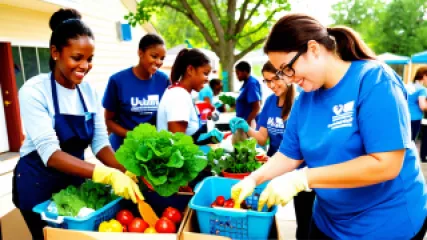How Volunteering Changed My Life: A Personal Journey
How Volunteering Changed My Life: A Personal Journey
The Spark That Ignited My Passion
My name is Elsie Perry, and I'm about to share with you a story that has profoundly shaped who I am today. It all began a few years ago when I found myself at a crossroads in my life, unsure of the path I wanted to take. I was working a corporate job that paid the bills, but it left me feeling unfulfilled and disconnected from the greater good.
One day, as I was scrolling through social media, I came across a post about a local volunteer organization that was looking for help. Something about the opportunity spoke to me, and without hesitation, I decided to take the plunge. Little did I know that this decision would be the catalyst for a transformative journey that would forever change the course of my life.
Discovering the Joy of Giving Back
When I first stepped into the volunteer organization, I was immediately struck by the infectious energy and passion of the people around me. Everyone seemed to radiate a sense of purpose and fulfillment that I had been desperately craving. As I listened to the stories of the individuals they were serving, I couldn't help but feel a deep connection to their struggles and a burning desire to make a difference.
At first, I was a bit nervous about the prospect of volunteering. I had never done anything like this before, and I wasn't sure if I had the skills or the confidence to make a meaningful impact. But the team welcomed me with open arms, and they quickly put my mind at ease, assuring me that the most important thing was my willingness to help.
As I began to immerse myself in the various volunteer activities, I was amazed at the sense of purpose and fulfillment that started to fill my heart. Whether it was sorting donations, preparing meals for the homeless, or tutoring underprivileged children, every task felt important and rewarding. I found myself looking forward to my volunteer shifts, eagerly anticipating the opportunity to make a difference in the lives of others.
The Transformative Power of Volunteering
As the weeks and months passed, I began to notice a profound shift within myself. The stress and anxiety that had once consumed me slowly started to melt away, replaced by a deep sense of contentment and inner peace. I found myself becoming more patient, more empathetic, and more attuned to the needs of those around me.
One of the most remarkable changes I experienced was a newfound confidence in my own abilities. Through the various volunteer tasks, I discovered hidden talents and strengths that I never knew I possessed. Whether it was organizing a successful fundraiser or leading a group of volunteers in a community project, I found myself stepping up to the challenge with a sense of purpose and determination that I had never felt before.
But the most significant transformation, however, was the way in which volunteering impacted my overall well-being. As I engaged in these acts of service, I found that my mood and mental health began to improve dramatically. The volunteering perks I experienced, such as the volunteering benefits for improving mood and combating depression, were truly life-changing.
I noticed that I was sleeping better, had more energy, and felt a greater sense of personal growth and fulfillment. The volunteering advantages I discovered went far beyond just the satisfaction of helping others – they also had a profound impact on my own well-being and happiness.
Embracing a Life of Service
As I continued to volunteer, I found that my initial passion for giving back only grew stronger. I started to seek out new opportunities to get involved, whether it was through local organizations or international initiatives. I discovered a deep sense of purpose and fulfillment in the act of serving others, and it became an integral part of my identity.
Volunteering also opened up a whole new world of connections and relationships for me. I found myself surrounded by like-minded individuals who shared my passion for making a difference, and we formed a tight-knit community built on mutual respect, empathy, and a shared commitment to the greater good.
Through these relationships, I not only gained valuable insights and perspectives but also found a sense of belonging that I had been missing in my life. The volunteering benefits for personal growth were profound, and I found myself becoming a more well-rounded and compassionate individual as a result.
A Legacy of Positive Impact
As I look back on my journey, I am truly amazed at the transformative power of volunteering. What started as a simple decision to give back has blossomed into a lifelong commitment to service and a deep sense of purpose that permeates every aspect of my life.
Through my volunteering experiences, I have had the privilege of witnessing the tangible impact that our collective efforts can have on the lives of others. Whether it's the smile on the face of a child who received a warm meal or the grateful tears of a family who found shelter and support during their time of need, these moments serve as a constant reminder of the profound difference we can make when we come together in service.
And as I continue on this journey, I am filled with a profound sense of gratitude and humility. Volunteering has not only changed my life but has also inspired me to become a force for good in the world. It is my hope that by sharing my story, I can inspire others to embark on their own transformative journeys of giving back and making a positive impact on their communities and the world at large.
Conclusion: The Ripple Effect of Volunteering
In the end, my journey with volunteering has taught me that the greatest gift we can give is not material in nature, but rather the gift of our time, our compassion, and our unwavering commitment to making the world a better place. By stepping outside of our comfort zones and embracing the power of service, we unlock a world of possibilities – not only for those we serve, but for ourselves as well.
The volunteering benefits list is truly endless, and the volunteering advantages extend far beyond the immediate impact of our actions. Through our collective efforts, we have the power to create a ripple effect of positive change that can reverberate throughout our communities and beyond.
So, if you find yourself at a crossroads, unsure of the path you want to take, I encourage you to consider the transformative power of volunteering. It just might be the spark that ignites a journey of self-discovery, personal growth, and enduring positive impact – one that, like mine, will forever change the course of your life.






